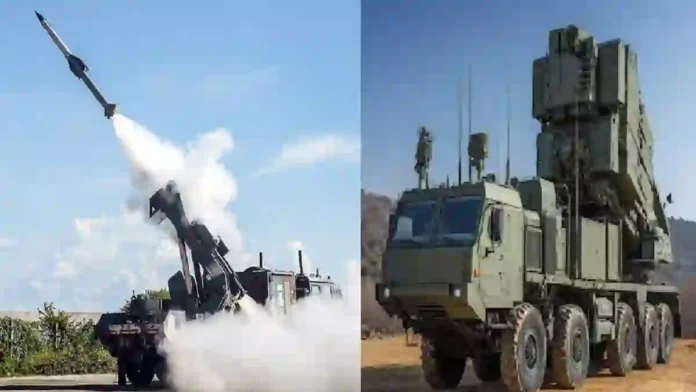The Defence Research and Development Organisation (DRDO) has recently been tasked with preparing the Detailed Project Report (DPR) for the new and ambitious air defence mission named “Sudarshan Chakra.”, said Defence Secretary Rajesh Kumar Singh in a briefing with the media. This mission represents a significant stride in India’s quest for a comprehensive, multi-layered air and missile defence shield that is planned to be fully operational by 2035.
Announced by Prime Minister Narendra Modi during the 79th Independence Day celebrations in 2025, Mission Sudarshan Chakra aims to establish a powerful, integrated air defence system that protects critical civil and strategic infrastructure across the country from evolving aerial threats, including aircraft, missiles, drones, and hypersonic glide vehicles.
At its core, Sudarshan Chakra seeks to combine legacy systems with state-of-the-art Indigenous technologies into a seamless defensive umbrella. The architecture envisages a layered shield operating at multiple altitudes and ranges, incorporating long-range, medium-range, and short-range weapon systems.
This multi-tiered system integrates various components such as quick-reaction surface-to-air missiles (QRSAM) with ranges around 30 km, very short-range air defence systems (VSHORADS) effective up to 6 km, and high-energy directed energy weapons (DEW) like laser-based arms capable of neutralising drones and other fast-moving targets within approximately 3.5 km.
These components work in conjunction with a centralised command and control centre developed by DRDO that orchestrates real-time detection, tracking, and engagement of aerial threats through AI-enabled interception capabilities.
The Sudarshan Chakra framework is also supported by advanced surveillance and early-warning assets, including satellites, radar networks resistant to jamming, and AI-driven sensors that collectively form its outermost protective shell.
These assets enable early threat detection and provide critical data inputs for decision-making and target prioritisation. This integrated defensive grid not only defends fixed critical assets such as Delhi NCR, nuclear bases, major military command centres, naval ports, energy hubs, and civilian infrastructure like hospitals and railways, but also envisions mobile deployment capabilities to shield frontline troops and battalions in active conflict zones.
Read- US Team To Visit India To Negotiate Sale of Six P-8I Maritime Patrol Aircraft
Read- Trump Tariffs Threaten To ‘Destroy’ 25 Years of US-India Partnership, Warn Former Diplomats
A key strategic aspiration of this mission is to establish a self-reliant Indian air defence ecosystem that rivals global contemporaries by blending the best features of systems like Israel’s Iron Dome, America’s THAAD, and Russia’s S-500, but customised for India’s complex multi-front threat environment.
The project also promises to incorporate offensive capabilities to conduct precision strikes alongside traditional intercept missions, enhancing deterrence and operational flexibility.
DRDO’s recent successful trials under the Integrated Air Defence Weapon System (IADWS) umbrella—which is part of Mission Sudarshan Chakra—demonstrated the simultaneous engagement and neutralisation of multiple aerial targets at various altitudes and speeds.
This test involved drones, high-speed unmanned vehicles, and other simulated enemy threats, validating the system’s multilayer defence capability.
Additionally, the DRDO’s ability to fuse kinetic interceptors with non-kinetic means such as electronic warfare tools, laser weapons, and cyber protection forms a comprehensive shield that addresses the full spectrum of aerial challenges, including traditional missiles, cruise missiles, UAV swarms, and future hypersonic threats.
The Sudarshan Chakra mission is expected to be a landmark project that brings together tri-service integration along with an interoperable network linking the Indian Army, Air Force, and Navy air defence units.
This integration aims to ensure an overlapping and coordinated defensive response to enemy incursions, increasing survivability and resilience. The Centralised Command and Control Centre will dynamically allocate appropriate interceptors and countermeasures based on threat characteristics like trajectory, velocity, and radar signature.
Read- Navy Outlays Its Plans To Expand The Fleet To Over 200 Warships And Submarines By 2035
Importantly, this effort dovetails with India’s broader defence modernisation and indigenisation goals, as the entire Sudarshan Chakra project, including its missile systems, sensors, radars, and command infrastructure, is being designed and manufactured domestically.
The mission underlines a national resolve to leverage cutting-edge technology—AI, satellite surveillance, directed energy systems, and electronic warfare—in a unified framework to safeguard India’s sovereignty and critical installations by 2035.
The DPR preparation by DRDO for the Sudarshan Chakra will detail the roadmap, technology integration, system capabilities, infrastructure development, and deployment plans for building India’s next-generation multi-layered air and missile defence shield.
This strategic initiative marks a game-changing transformation in India’s aerial defence posture, intending to provide a robust shield against 21st-century aerial threats, reinforcing national security with high precision, quick reaction, and comprehensive coverage.
The system is not only about defence but also about enhancing India’s offensive air defence capabilities, promoting self-reliance, and projecting a credible deterrence against emerging threats from hostile actors, thus contributing significantly to national security architecture modernisation.
Key aspects of Mission Sudarshan Chakra include:
Development of an integrated air defence system (IADWS) that combines various quick reaction surface-to-air missiles (QRSAM), very short-range air defence systems (VSHORADS), and directed energy weapons capable of engaging multiple targets at different altitudes and ranges simultaneously.
The system will incorporate advanced sensors, AI-enabled threat detection, real-time command and control, and space-based tracking assets to provide a layered defence umbrella.
It will build on India’s existing missile defence capabilities like the S-400, Barak-8, and Akash systems and aim to counter not only traditional airborne threats but also emerging ones such as swarms of drones and hypersonic missiles.
The initiative focuses on indigenous research, development, and manufacturing to ensure strategic autonomy and self-reliance. Mission Sudarshan Chakra seeks to provide rapid, precise defensive and retaliatory capabilities, creating a strong deterrence effect. The system will integrate with India’s air defence forces and facilitate coordinated, multi-layered defence coverage nationwide.
DRDO’s task to prepare the DPR is aimed at identifying gaps in the current air defence architecture and planning the technological, operational, and infrastructure frameworks needed to realise this ambitious mission.
IDN (With Agency Inputs)
Agency




